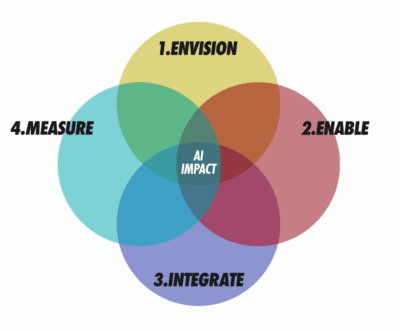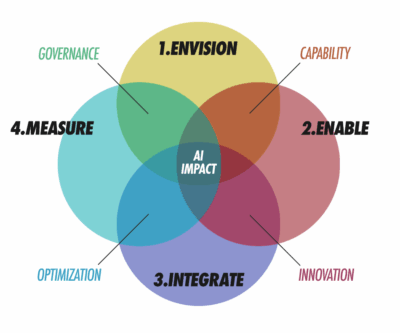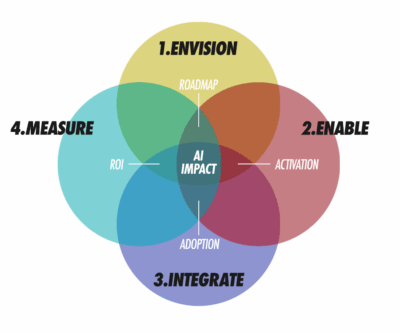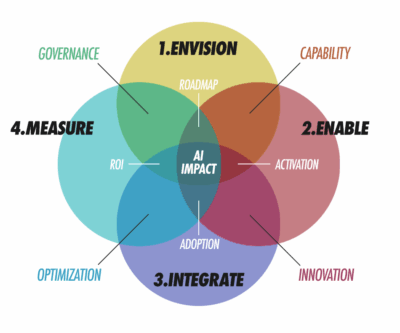Everyone is talking about AI, but most marketing teams are stuck in pilot purgatory (endless testing that never makes it to production). It’s been reported that AI project failure estimates run as high as 80%! I’ve spent the last year helping teams break this pattern.
The problem isn’t the technology; it’s trying to bolt AI onto existing processes instead of rethinking how to truly empower teams. As we help our clients navigate AI adoption, we’ve identified four core “drivers” working together to achieve the AI impact your organization seeks. This framework has helped several of them move from PowerPoint promises to measurable results.

The Four Drivers of AI Impact
- Envision
Everything starts with a clear picture of the future. You identify ways AI can help automate or expedite internal operations, how generative models can reshape customer journeys, and where predictive analytics can find new opportunities. A vision that’s thoroughly communicated organizationally (including the “why” and “what’s in it for me”) and supported by leadership gets AI investments on the right track.
- Enable
Vision without the means to act is wishful thinking. To enable AI, you must equip your teams with the right skills, tools and data. This is where you run training workshops, select and license the right software (you don’t have to build everything!) and prepare your data to be useful. It’s about creating the conditions for success.
- Integrate
Here, AI moves from a separate tool to a core part of the workflow. You don’t just give someone a new app; you embed its power directly into the creative brief, the CRM or the ad-buying platform. Integration is uncomfortable because it forces you to change how you work and prune legacy steps. Working with change champions as early adopters helps build desire across the organization when others see their engagement and outcomes. The payoff is capacity (hours you can redeploy to higher-value creative and strategic tasks).
- Measure
You measure twice: first to see if people are actually using the new capabilities, then to prove the business impact. Are teams using the new AI copilot? Do campaigns show a lift in return on ad spend, customer lifetime value or content throughput? Transparent metrics turn AI from a novelty into a habit and give leadership the evidence it needs to double down.

When Two Drivers Work Together
When these drivers start working together, they create powerful reactions that build momentum.
Capability (Envision + Enable): A vision for personalized outreach is just a dream. But when you pair that vision with a newly licensed generative AI platform, you create a tangible capability for your team to draft tailored emails at scale. The abstract becomes possible.
Innovation (Enable + Integrate): This is where new, better ways of working are born. A new tool is just a tool. But when you integrate that AI platform directly into your CRM, you can innovate the sales process. Your team now works smarter, without ever leaving their primary screen.
Optimization (Integrate + Measure): Real usage data from an integrated tool creates a feedback loop. An automated weekly report that flags campaigns where AI-generated copy underperforms human baselines, then routes them for refinement, turns a static project into a self-improving system.
Governance (Measure + Envision): Evaluations keep the vision grounded. By constantly comparing your performance metrics against your strategic goals and brand safety guidelines, you establish the proper policies and reviews to ensure your AI program stays on track.

Where the Triple Overlaps Deliver Outsized Value
The real transformative value appears when three drivers fire in concert.
Roadmap (Envision + Enable + Measure): A real roadmap is more than a wish list. It’s a grounded (yet evolving) plan created by combining a clear vision, the specific tools and skills you need to enable, and the metrics that will define success. It’s the difference between saying “we should use AI for video” and having a plan that states, “We will enable the team with HeyGen to measure our ability to cut video production time by 50%, in service of our vision to become the dominant voice in our category on TikTok.”
Activation (Envision + Enable + Integrate): This is the magic moment where potential becomes reality. Activation happens when the goal (Envision), the tool (Enable) and the workflow change (Integrate) all come together. It’s when that new AI design assistant is fully embedded in the team’s creative workflow, finally allowing them to execute the C-suite’s vision for high-velocity content testing. The idea becomes a living, breathing part of the operation, with employees actively engaged in their new capabilities.
Adoption (Enable + Integrate + Measure): Sticky adoption doesn’t come from mandates; it comes from removing friction, proving value, and peer-based social proof (FOMO is a powerful motivator). People will flock to a new tool when it’s available (Enable), easy to access within their existing process (Integrate), and they can see that it works (Measure). A new AI tool sees widespread adoption only when the metrics clearly show it cuts reporting time in half without making people leave their familiar spreadsheet program.
ROI (Envision + Integrate + Measure): This is how you prove your work matters to the C-suite. Return on investment (ROI) is the story you tell when you connect a process change to a financial result. When you can show that integrating a predictive analytics tool into your media buying process (Measure) led to a 12% lift in marketing contribution to revenue, you’re not just sharing a metric. You are proving the financial return of the strategic AI bet you envisioned from the start. Beyond ROI, tracking return on engagement (ROE) ensures teams stay creatively involved in envisioning new opportunities, starting the flywheel again.

Getting Started This Quarter
Of course, this internal machine doesn’t operate in a vacuum. It’s constantly influenced by shifts in the market, available technology and customer expectations. But the best way to adapt to those forces is to get your own house in order first while remaining agile.
Plot your current state across Envision, Enable, Integrate and Measure using a simple green/yellow/red score. Select one paired approach overlap for a 60-day quick win — progress there forces momentum in the adjacent circles. Choose one triple-overlap outcome as a 90-day objective that turns that momentum into measurable business value.
The organizations winning with AI aren’t the ones with the biggest budgets. They’re the ones moving fastest through this cycle. While your competitors debate AI tools and strategy in conference rooms, you can be building the capabilities that actually ship. Start the flywheel this quarter, and six months from now, you’ll be the team others are trying to catch.




